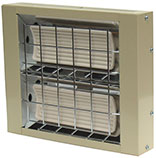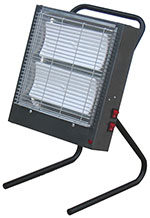
| ||||
W. Tombling Ltd.
Wembley House
Dozens Bank
West Pinchbeck
Spalding
Lincolnshire
PE11 3ND
U.K.


|
You are here:- home > heater index > radiant heating index > electric radiant heating
Electrical radiant heating
Electrical radiant heating is gaining popularity for heating industrial premises because it has many advantages over traditional warm air heating, not least that it can reduce heating costs considerably.To understand why electrical radiant heating is suited to heating industrial premises, we need first to understand the nature of the buildings themselves.
The typical industrial premises
Until very recently the typical factory, workshop, warehouse etc. was not built with energy efficiency in mind, it is normally a large open plan space with:- High ceilings - where the warm air from traditional warm air heaters gathers, while cold air settles at floor level (stratification).
- Open doorways or loading bays - which allow warm air to escape and cold drafts in.
- Poorly sealed and insulated - leading to high heatloss.
- They present a risk of fire if knocked over.
- They burn up oxygen and produce fumes.
- Gas bottles must be stored safely.
Electrical radiant heating in industrial premises
Electrical radiant heating is a safe and economical solution to these problems. It is unaffected by the energy inefficient design of the typical industrial building, and is easily targeted to provide heat only where it is needed.Electrical radiant heaters produce infrared rays that travel through the air without heating it, when they strike a surface the energy is converted to heat. They are therefore an ideal way to deliver economical, focused heating with a fraction of the wastage associated with warm air heating.
Electrical radiant heating is instant, the heaters achieve maximum output within 2 minutes, and because their heat is direct (the surrounding air is not heated), warmth is felt immediately.
Additional benefits of electrical radiant heating
Electrical radiant heating has a number of additional benefits:- There is no air movement, so dust, dirt and air borne particles are not disturbed.
- There are no fumes or odours.
- Humidity levels are unaffected, there is no condensation from the combustion process, and the air is not dried out.
Activair electrical radiant heaters
Activair wall mounted radiant heaters are specifically designed for industrial applications.
They have tough ceramic emitters, which are unaffected by knocks, water splashes etc.
Unlike radiant heaters that use glass lamps the ceramic emitters will not shatter, and they have a
lifespan measured in years, not hours.Activair electrical radiant heaters are available in a wide range of outputs for suspended or wall mounted installation. They are easy to install and control.

A handy portable radiant heater is also available for temporary applications.
Electrical radiant heating is a clean, safe, robust and economical way to heat industrial premises, which would otherwise be difficult and expensive to heat with traditional warm air heaters. It is a viable alternative to bottled gas heaters and allows businesses to satisfy both their health and safety and energy efficiency requirements.
For further information on electrical radiant heating, visit the radiant heating homepage.
You are here:- home > heater index > radiant heating index > electric radiant heating
If you found this page useful, please take a moment
to tell a friend or colleague about it.
Copyright © 2004/6, W. Tombling Ltd.